Content
- Characteristics and properties
- Norm
- Reasons and reasons for rejection
- Diabetes
- Bunty disease
- Tuberculous pleurisy
- Leukemia
- Hypofibrinogenemia
- Hyperfibrinogenemia
- Anemia
- Thrombocytopenia
- Werlhof's disease
- Increased hematocrit
- How is it determined
- How to bounce back
- Antibacterial therapy
- Treatment with glucocorticosteroids
- Plasmapheresis
- Surgery
- Replenishing iron deficiency
- Video about hemostasis
Blood clot retraction (RCS) is one of the stages of blood clotting under the influence of internal factors of the body or the influence of the external environment. The indicator reflects the general functional state of coagulation hemostasis of the bloodstream.
The complete absence, increase or decrease in the level of retraction of the blood clot indicates the presence of acute as well as chronic diseases of the blood and hematopoietic system. Pathologies associated with impaired indicators of r.c.s. can be congenital or acquired at a certain stage of life.
Characteristics and properties
Clot retraction is a hematological process of compaction and gradual reduction of a certain volume of blood, as well as the release of its serum after the formation of a sufficient amount of fibrin. During the analysis, this indicator is taken into account 2 main characterizing the properties of the investigated blood clot.
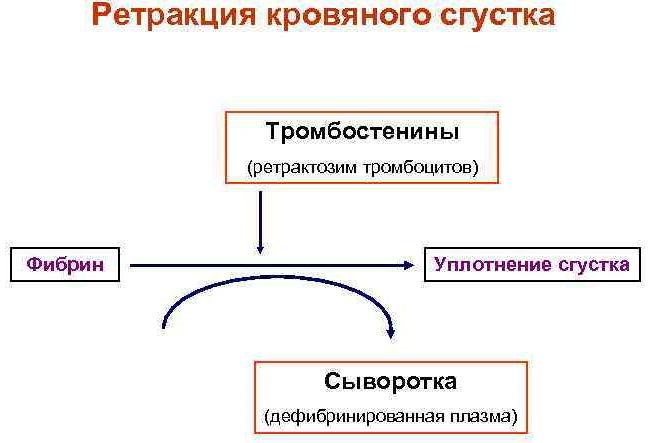
This is the volume of serum that was excreted after the formation of a clot, as well as its ratio to a certain amount of blood collected. The main property of blood clot retraction is participation in the process of stopping bleeding in case of damage to the vessel. By determining this indicator, a number of hematological diseases are diagnosed.
Norm
Blood clot retraction is the level of compaction and contraction of a certain blood volume, which is different relatively stable indicators for people of all age categories, regardless of their gender accessories. The table below shows the reference values for this blood property.
| Minimum blood clot retraction rate | Maximum blood clot retraction rate |
| Not less than 45% | Not more than 65% |
Deciphering the clinical meanings of blood clot retraction is carried out by a hematologist. During the study of the results of a blood test, the presence or absence of the patient is taken into account chronic diseases of the body, its lifestyle, occupation, addiction to tobacco smoking and alcoholic beverages.
The objective level of blood clot retraction can be distorted by the effect of the constituent substances of drugs that were used 24 hours before donating blood. Therefore, in the process of determining the norm of this indicator, the hematologist takes into account all factors that can affect the results of laboratory research.
Reasons and reasons for rejection
Retraction of a blood clot is the process of blood clotting, which is a protective reaction of the body to the effects of certain factors.
Increase or decrease in the indicator of r.c.s. is considered equally dangerous to humans, and also indicates the presence of serious hematological diseases. In medical practice, there are occasional cases when the absence of full retraction blood clot, diagnosed in patients with inflammatory lesions of the lung tissue and abdominal cavity.
Diabetes
Diabetes mellitus is a disease of the human endocrine system, as a result of which the pancreas is disrupted to synthesize the required volume of insulin.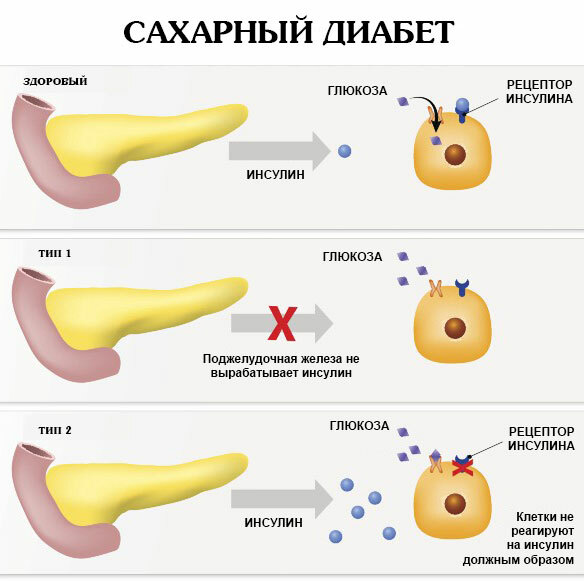 Unstable blood glucose levels lead to the development of a severe complication in the form of hemorrhagic syndrome. The patient's blood vessels become brittle, blood clotting decreases significantly, which leads to the absence of the process of retraction of the blood clot.
Unstable blood glucose levels lead to the development of a severe complication in the form of hemorrhagic syndrome. The patient's blood vessels become brittle, blood clotting decreases significantly, which leads to the absence of the process of retraction of the blood clot.
Bunty disease
Bunty's disease is another pathological reason why indicators deviate from the norm. r.c.s. This disease is splenogenic type liver cirrhosis with simultaneous tissue damage spleen. Bunty's disease not only causes disruption in the functioning of these organs, but also leads to a gradual decrease in the level of blood platelets.
As the pathology progresses, the process of blood clot retraction deviates from the normal values downward. The main danger of this cause of poor blood clotting is the rapid progression of cirrhosis, which soon leads to death.
Tuberculous pleurisy
Tuberculous pleurisy is a serious disease of the body, which is characterized by inflammation of the pleural membranes located in the circumference of the lung tissue. The pathological process is localized in the visceral and parietal segments of the pleura.
A complication of this disease is the accumulation of effusion, as well as a violation of blood clotting, which leads to a complete absence of retraction of the blood clot. This type of pathology most often affects men of all age categories, but is much less common in women.
Leukemia
Leukemia is a malignant damage to bone marrow cells that results in the production of altered white blood cells. As this disease progresses, a general violation of the cellular composition of the blood develops. Leukemia can be acute or chronic.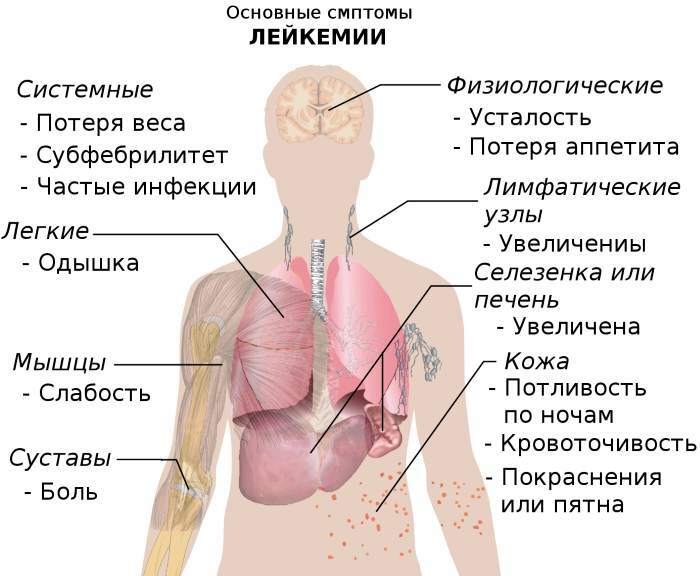
In the later stages of hematological pathology, a decrease in the level of platelets is observed, the natural process of blood clotting is disrupted with the absence of retraction of the blood clot. Clinical studies have shown that men develop leukemia 1.5 times more often than women.
Hypofibrinogenemia
Hypofibrinogenemia is a pathological condition of the blood in which the level of fibrin ranges from 0.5 to 1.5 g / l. An insufficient amount of this substance leads to the fact that in the event of vascular damage, the blood loses its physiological coagulation function. Correspondingly, the level of retraction of the blood clot decreases.
Hypofibrinogenemia can develop under the influence of the following factors:
- negative consequences of thrombolytic therapy;
- severe pathologies of the liver and pancreatic tissues;
- taking medications that belong to the pharmacological group of direct anticoagulants.
A decrease in the retraction index of a blood clot due to hypofibrinogenemia is dangerous by the opening of internal bleeding, profuse blood loss in case of damage to the soft tissues of the body.
Hyperfibrinogenemia
In conditions of hyperfibrinogenemia, an increase in the level of fibrin occurs with a simultaneous increase in blood clot retraction. In this case, the risk of developing thrombosis of large vessels increases, the migration of which can lead to blockage of blood circulation, ischemia, as well as infarction of tissues of internal organs.
Anemia
Anemia is another pathological factor that disrupts the level of blood clot retraction upward. The presence of this disease is characterized by a gradual decrease in the concentration of red blood cells with a drop in hemoglobin indices. Against this background, there is an imbalance in the cellular composition of the general blood flow. Anemia is considered one of the most common causes of increased retraction of the blood clot.
Against this background, there is an imbalance in the cellular composition of the general blood flow. Anemia is considered one of the most common causes of increased retraction of the blood clot.
Thrombocytopenia
Thrombocytopenia is a cause of decreased blood clot retraction, which is a hematological disorder. The development of this pathology is associated with a decrease in the numerical number of platelets to the limit of 150 per 10-9 liters of venous blood. The more severe the form of thrombocytopenia, the lower the blood clot retraction rates. This type of disease is accompanied by significant difficulties in stopping bleeding.
Werlhof's disease
Werlhof disease is a serious blood disorder also known as primary immune thrombocytopenia. The peculiarity of this pathology lies in the fact that under the influence of the own cells of the human immune system, an active destruction of platelets occurs.  Against the background of an acute autoimmune reaction, hemorrhagic syndrome develops with a decrease in blood clot retraction rates.
Against the background of an acute autoimmune reaction, hemorrhagic syndrome develops with a decrease in blood clot retraction rates.
Increased hematocrit
An increase in hematocrit occurs due to a decrease in fluid in the blood. At the same moment, there is an increase in the concentration of red blood cells and a drop in the level of platelets. The latter effect causes a violation of the rate of retraction of the blood clot downward.
How is it determined
The retraction of a blood clot is a physiological property of blood that manifests itself at the time of its clotting. To determine this indicator, you need to visit a public or private laboratory, or a diagnostic center specializing in performing a hemostasiogram. To perform this analysis, you will need to donate from 5 to 10 ml of venous blood. The biological material is collected under sterile conditions in the manipulation room.
The patient's venous blood is immediately sent to the department of the biochemical laboratory, where the level of retraction of the blood clot is determined within 2 working days. The average cost of this study in a private diagnostic center is from 650 rubles. A hemostasiogram is considered a simple blood test.
To conduct a study on the level of blood clot retraction, the following preparation rules must be followed:
- 1 day before the test, provide the body with good rest, give up heavy physical labor and sports activities;
- come to the clinic without having breakfast, since blood must be donated on an empty stomach;
- 48 hours before the visit to the diagnostic center, you must adhere to a diet, excluding foods containing protein and fats from your menu;
- the last meal should take place no later than 12 hours before the selection of biological material;
- 24 hours before donating blood, you must stop drinking alcohol.
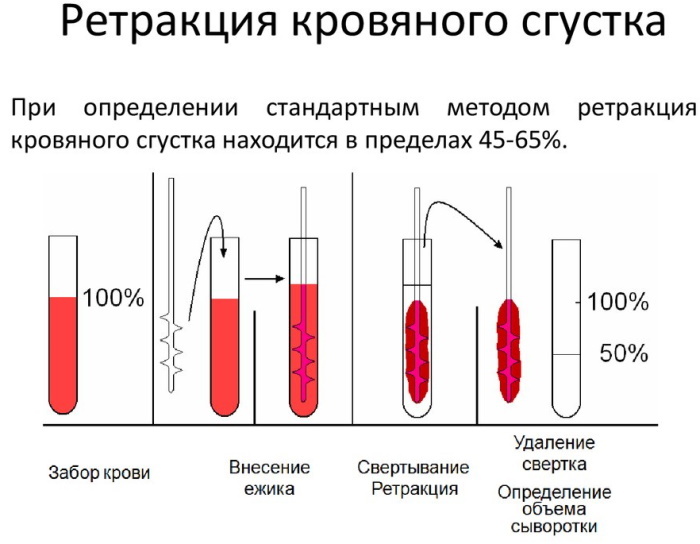 Patients with diabetes mellitus are allowed to have a light snack, but no later than 4 hours before visiting the clinic. In case of undergoing drug therapy, it is necessary to provide the doctor with all information about the type of medication.
Patients with diabetes mellitus are allowed to have a light snack, but no later than 4 hours before visiting the clinic. In case of undergoing drug therapy, it is necessary to provide the doctor with all information about the type of medication.
This factor will be taken into account when decoding the results of a blood test. For example, some types of drugs can affect the level of platelet activity. Women should have a blood clot retraction test after completing their period.
How to bounce back
To bring blood clot retraction indicators back to normal, it is necessary to carry out complex therapy of the underlying disease that provokes the development of hematological pathology. The treatment strategy is selected by the doctor based on the results of the patient's diagnosis.
Therapy to restore the normal level of blood clot retraction is carried out in a hospital setting. And the patient himself is under round-the-clock supervision of medical personnel. Especially if there is a risk of opening internal bleeding.
Antibacterial therapy
A decrease in blood clot retraction rates, which is caused by tuberculous pleurisy, is restored to a normal state by eliminating the underlying pathology.
In this case, the following drugs are used that exhibit therapeutic activity against the infectious agent of tuberculosis:
- Isoniazid - the dosage is selected at the rate of 10 mg of the active substance per 1 kg of the patient's body weight.

- Streptomycin - about 1 g per day.
- Ethambutol - within 25 mg of the main component per 1 kg of patient weight.
- Rifampicin - from 0.45 to 0.6 g per day, depending on the general condition of the patient.
The restoration of blood clot retraction indices to the normal level occurs immediately after the elimination of the focus of the inflammatory process. The average duration of treatment for tuberculous pleurisy and complications associated with this pathology is 10 to 12 months.
Treatment with glucocorticosteroids
This method of normalizing blood clot retraction indices is used for patients diagnosed with Werlhof's disease. Throughout the entire course of treatment, the main emphasis is on achieving an anti-inflammatory effect, as well as reducing the aggressive properties of the patient's immune system. Patients are prescribed an intravenous infusion of Dexamethasone at a dosage of 40 mg. The duration of the therapeutic course is 4 days.
With insufficient effectiveness of Dexamethasone, additional drugs are used in the form of:
- Rituximab;
- Thrombopoietin;
- Fostamatinib.
To neutralize the autoimmune process, drugs from the group of immunosuppressants Azathioprine, as well as Cyclosporine, can be used. In conditions of the need for a rapid increase in the level of retraction of the blood clot, intravenous droppers based on immunoglobulin and thromboconcentrate are used.
Plasmapheresis
Plasmapheresis is an effective method of restoring blood clot retraction indicators by normalizing blood platelet levels. The application of this method consists in the use of donor material. With the help of special equipment, blood separation is performed with the separation of its plasma and cells of various types.
During plasmapheresis, a patient suffering from thrombocytopenia is given an intravenous infusion of donor platelets. Due to the normalization of the indicators of these blood cells, the effect of stabilizing the level of retraction of the blood clot is achieved. Plasmapheresis is carried out in the hospital of the hematology department in compliance with strict standards of sterility. The frequency of the procedure depends on the level of retraction of the blood clot as well as the general health of the patient.
Surgery
The method of surgical intervention is used in cases where leukemia is found in a patient with signs of an impaired blood clot retraction rate. In this situation, in combination with chemotherapy drugs, bone marrow transplantation from a donor person is performed. Successful surgical treatment of leukemia makes it possible to restore the cellular balance of the blood, as well as the normal level of retraction of the blood clot.
Surgical intervention is carried out in the sterile conditions of the surgical room. At the time of the operation, the patient is under the influence of general anesthesia. The postoperative period requires a course of rehabilitation, the duration of which is 1-2 months. depending on the complexity of the clinical case.
Replenishing iron deficiency
Retraction of a blood clot is one of the stages of thrombus formation, the violation of which can occur due to the presence of iron deficiency anemia.
In this case, the patient is prescribed the following medications:
- Aktiferrin in capsules with a dosage of 0.4 g;
- Venofer solution for injection in ampoules with a capacity of 5 ml each;
- Solgar Readily available iron (Gentle Iron) in the form of gelatin-coated capsules;
- Maltofer tablets for chewing in the mouth with a dosage of 100 mg of iron;
- Aktiferrin drops in 30 ml vials;
- Maltofer syrup at a dosage of 10 mg per 1 ml (1 bottle contains 150 ml of the drug).
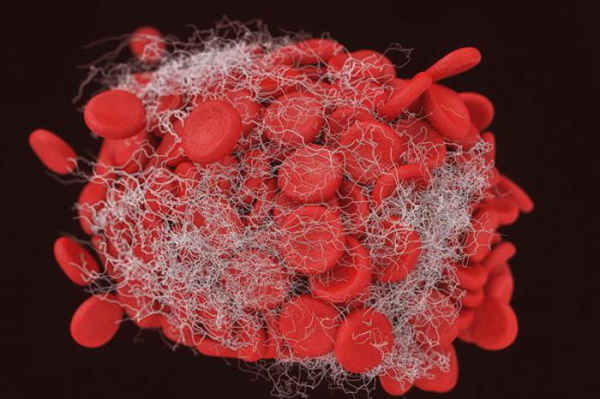 The dosage regimen of the above drugs is determined by the attending hematologist or therapist, depending on the results of a laboratory study of the patient's venous blood.
The dosage regimen of the above drugs is determined by the attending hematologist or therapist, depending on the results of a laboratory study of the patient's venous blood.
The retraction of a blood clot is a physiological process consisting of a ratio of two quantities. This is the property of thickening and reducing the volume of blood during clotting. The rate of blood clot retraction is the same for children of all ages, adult men and women, and the elderly. The optimal value of this indicator is from 45 to 60%.
To determine the level of retraction of a blood clot, it is necessary to donate from 5 to 10 ml of venous blood. The results of the analysis are known after 1-2 working days, and they are deciphered by a hematologist or therapist. To restore blood clot retraction indicators to the normal level, it is necessary to treat the underlying disease, which provoked a violation of the blood clotting process.
Video about hemostasis
A brief overview of hemostasis:



